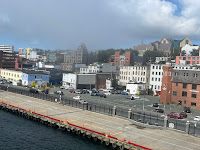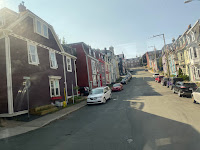We awoke the next morning to find our ship still sailing for the capital and largest city of the Canadian province of Newfoundland and Labrador, St. John’s.
 |
| Welcome to St. John's |
Founded by Basque fishermen at the beginning of the 16th century, it is one of the oldest cities in North America and was officially incorporated in 1888. Today, the St. John’s metropolitan area has a population of around 220,000 inhabitants.
 |
| Basilica of St. John the Baptist |
Up until its collapse in the 1990s, the cod fishing industry was the economic mainstay in Newfoundland and Labrador. Today the ocean still has a major economic importance, but it is due to the oil and gas that lies beneath it. There are currently four major offshore oil developments off the coast of the city.
Our ship finally docked just before noon and was given immediate clearance for disembarkation.
 |
| Old Cape Spear Lighthouse |
We had a shore excursion book for 1230, so we stayed on board until it was time for our group to meet. When it was time for our tour to begin, we boarded a bus and started to weave its way through the downtown St. John’s area, while our guide provided some background history about the area, its people, the different cultures, and the landmarks that we were seeing. Because St. John’s serves as the capital of the Newfoundland and Labrador province, there are numerous government buildings housing departments that provide administrative services which our guide pointed out as we passed them.
 |
| New lighthouse |
Of course, no city tour would be complete without a photo-op or discussion of its major religious institution, and the Basilica of St. John the Baptist fulfilled this requirement for St. John’s. The church is the seat of the Roman Catholic Archdiocese of St. John’s and is the largest religious institution in the city.
We left the downtown area and drove through the countryside on our way to Cape Spear Lighthouse National Historic Site. Located on the Avalon Peninsula about 12 miles from downtown St. John’s, but still within the municipal boundary, the Cape Spear lighthouse has been important to maritime navigation since 1836.
 |
| Easternmost point |
There are actually two lighthouses on the headland, the original and a new one built in 1955 with updated technology. The Cape is also the easternmost point in North America, excluding Greenland. Because of its proximity to convoy routes during World War II, a manned gun battery was installed on the Cape to defend the entrance to St. John’s harbor.
 |
| One of the big guns |
In 1942, a U.S. Army Ground Radar Early Warning Station was established on the site and operated until 1945.
We walked to the easternmost point and had our picture taken, then we explored the gun battery’s bunkers, tunnels, and remnants of gun emplacements. It was quite a hike up to the old and new lighthouses, so we decided to just take some long-distance photos and call it good. Back at the visitor center gift shop, Jane purchased a Cape Spear T-shirt and a shot glass. We left Cape Spear and headed back toward St. John’s by way of Petty Harbor, a quaint little fishing village with a snug harbor.
 |
| Water tunnel |
It looked like an ideal place to come back to and spend some time. On the outskirts of the village we saw a water tunnel—a large diameter pipeline—that brings freshwater from a reservoir several miles away to the villages that line the coast. We also passed several farm fields that our guide told us were not abundantly productive due to the thin layer of topsoil covering the rocky subsurface, and the very short growing season.
Back in the city we made our way to another historic site, Signal Hill. At a height of 548 feet, Signal Hill overlooks the city and the harbor.
 |
| Cabot Tower on Signal Hill |
Due to its strategic placement overlooking the only entrance to the harbor, defensive fortifications date back to the mid-17th century. Sitting atop the hill is Cabot Tower which was used for flag mast signaling and a Marconi wireless station. Historically, the hill is important as the site of the final battle of the Seven Years War in North America which was fought in 1762.
 |
| Signal Hill fortification |
In more modern times, the first transatlantic wireless transmission was received there by Guglielmo Marconi on December 12, 1901.
We exited our bus and walked around the grounds. Given the very narrow width of the entrance to St. John’s harbor, it was easy to see why this location was important to the defense of the city and harbor. The hill’s height provided some great vistas of the surrounding landscape. We took our pictures then boarded our bus for a ride back to the ship.
 |
| Channel to St. John's harbor |
Along the way, we passed through “Jellybean Row,” so named for the brightly colored houses that line the street. Back on board we had dinner and another team-winning session of “Brainteasers” to finish off the day.
 |
| Jellybean Row |

No comments:
Post a Comment